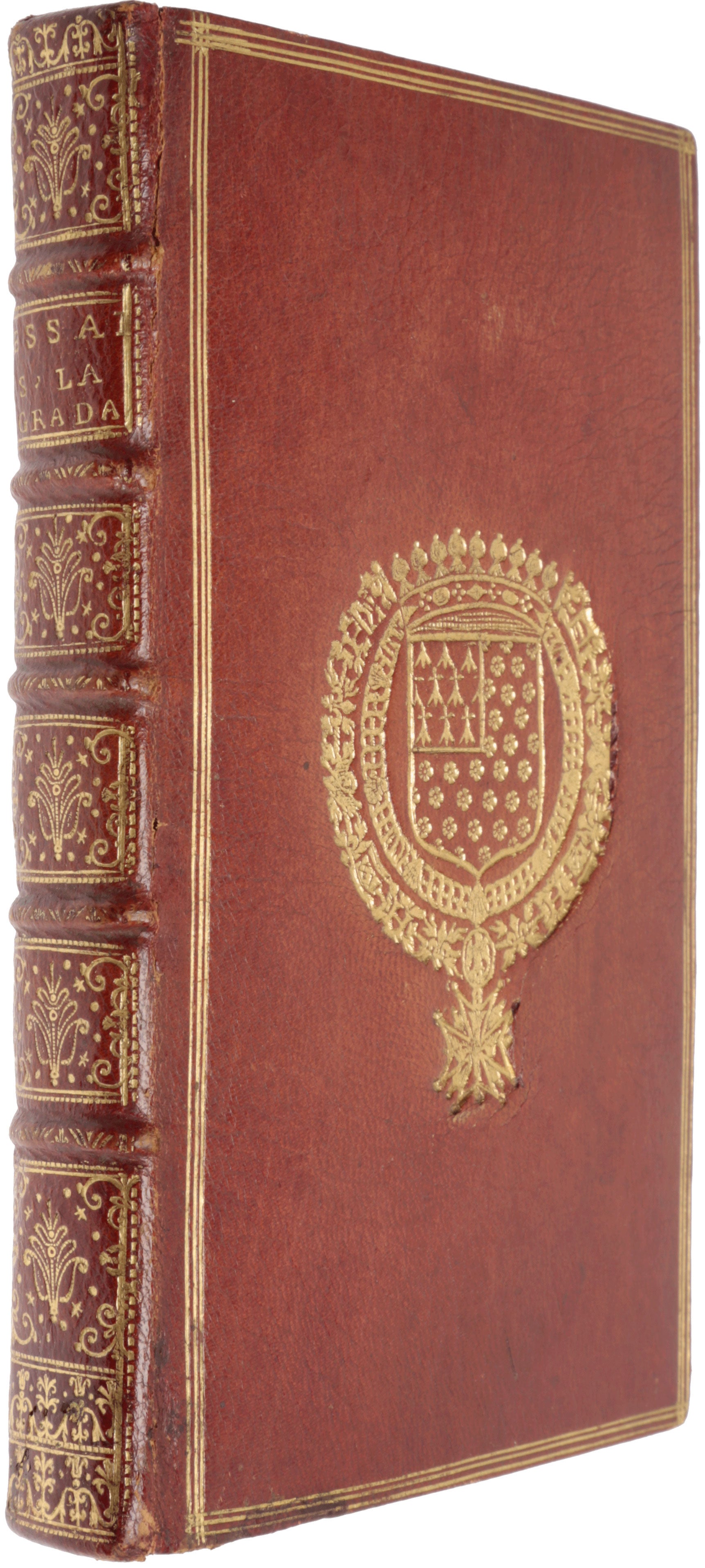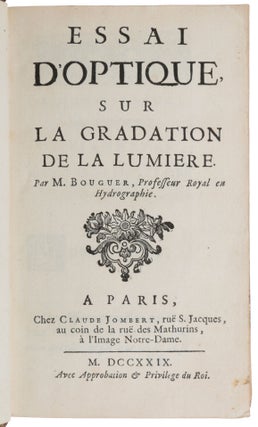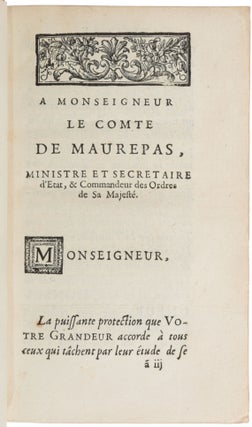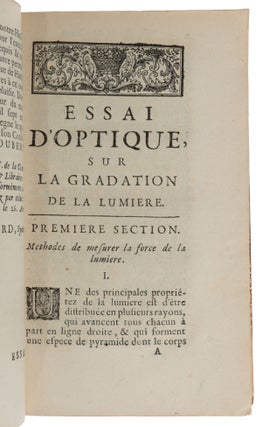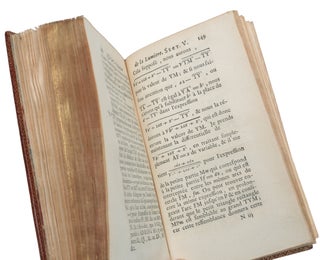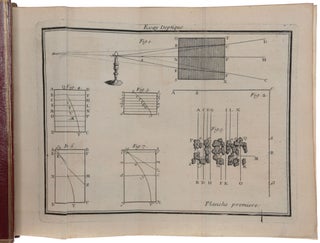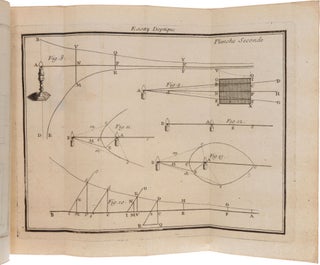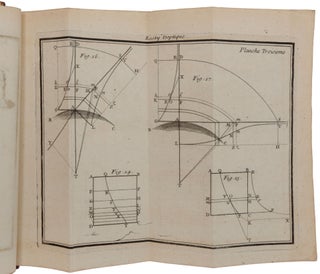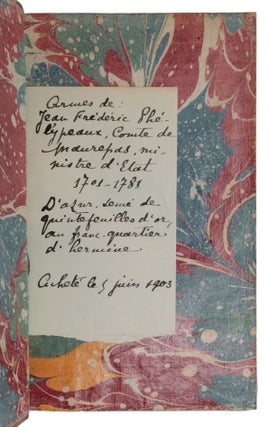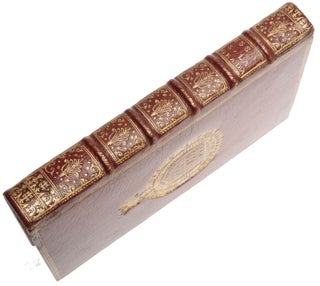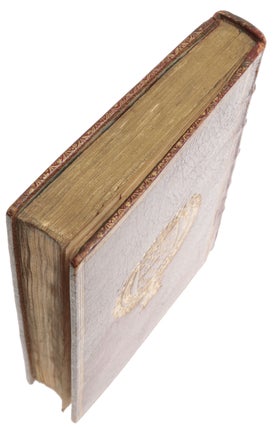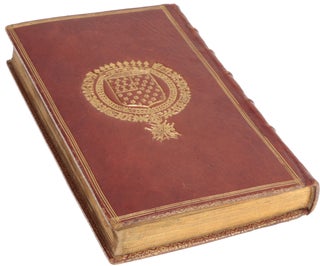Essai d’optique sur la gradation de la lumiere.
Paris: Claude Jombert, 1729. First edition of the founding work of photometry, a superb large-paper copy lavishly bound for the dedicatee, the Comte de Maurepas, Louis XV’s Minister of the Marine. “[Bouguer’s] interest in the measurement of light dates from about 1721, when J. J. d’Ortous de Mairan proposed a problem that necessitated a knowledge of the relative amount of light from the sun at two altitudes. Bouguer succeeded in making such a measurement of the light from the full moon on 23 November 1725, by comparing it with that of a candle. Bouguer’s achievement was to see that the eye could be used, not as a meter but as a null indicator, i.e., to establish the equality of brightness of two adjacent surfaces. He then made use of the law of inverse squares [that the intensity of light is proportional to the inverse square of the distance from its source], first clearly set forth by Kepler. In his Essai d’optique sur la gradation de la lumiére (1729), he showed how to compare lights in this way; he then went on to deal with the transmission of light through partly transparent substances. In the latter part of the Essai, Bouguer published the second of his great optical discoveries, often called Bouguer’s law: In a medium of uniform transparency the light remaining in a collimated beam is an exponential function of the length of its path in the medium. This law was restated by J. H. Lambert in his Photometria (1760) and, perhaps because of the great rarity of copies of Bouguer’s Essai, is sometimes unjustifiably referred to as Lambert’s law” (DSB). Although today Lambert’s work would be regarded as much rarer than Bouguer’s, at least on the market, and although Lambert’s book contains much that is not in Bouguer, it is nonetheless true that Bouguer anticipated Lambert in the formulation of ‘Lambert’s law’ by more than three decades. Bouguer was the leading French authority on navigational science, and published widely on geodesy and hydrography. He dedicated his Essai d'optique to the Comte de Maurepas. An honorary member of the Académie des Sciences, Maurepas had both a personal and professional interest in Bouguer’s work; from the 1720s though the late 1740s, his ministry promoted improvements in maps, navigation and shipbuilding, and directed scientific expeditions to Greece, the Far East, and Peru. Bouguer participated in the last of these. “In 1735 at the age of 38, while reluctant to travel outside of France because of suffering from sea-sickness and not in good health generally, Bouguer was enticed by Maurepas, with new astronomical instruments and other incentives, to join the expedition sponsored by the French Academy to measure the length of a degree of latitude at the equator5. Bouguer was known by Maurepas for his work on naval interests” (Henderson). Provenance: Jean-Frédéric Phélypeaux, Comte de Maurepas (1701-81) (arms on covers). Born at Versailles, Maurepas was trained from childhood to be secretary of state to the king of France. In 1723 he began his duties as Ministre de la Marine to Louis XV, administering the navy, colonies and seaborne trade. He retained this position until 1749, when he was removed in a coup led by the Duke de Richelieu. Skilled in military and naval strategy, Maurepas enabled the French navy to regain previously lost prestige, ensuring that France was once again recognized as a maritime power. “Bouguer (1698-1758) first wrote critically about questions of illumination in an essay published in 1729. In the preface, he describes that he took up the subject after reading a memoir by J. J. d’Ortous de Mairan. Mairan had attempted to show (without success) how, with a knowledge of the amount of light from the sun reaching the earth from two altitudes, the amount from other altitudes could be calculated. In a note in 1726, Bouguer initially tried to solve this specific problem, and published his successful results using the moon as subject and a candle as a comparison. From this, he developed means of attenuating light in measurable ratios. His Essai discusses how the brightness of light varies with distance from the light source, and discussed the means of determining it. He assumed an inverse-square law of illumination, which appears to have been appreciated by at least some writers at least a century earlier, although enunciated in various forms. Bouguer concluded that the eye was unreliable in measuring absolute brightness, and should instead be employed only to match two light sources. To make such a comparison, he devised a ‘lucimètre’ consisting of two tubes to be directed at the two light sources, and converging at a paper screen viewed by the eye. To use the device, the observer pointed the two tubes towards the two sources. The light through one tube could be attenuated partially by masking its aperture with an adjustable sector to make the two patches of light appear equal. From the reduction in aperture area, the ratio of the two intensities could be judged. In an alternate version, one tube could be lengthened, so that the light reaching the screen was reduced according to the inverse-square law” (Johnstone, p. 13). “In 1729 Bouguer published his influential Essai d'optique sur la gradation de la lumiere, which he aimed to found a new department of knowledge. “As optics has so far been confined to examining the situation or direction of rays, it still lacks an entire department the object of which would be the force or vivacity of light.’ This essay contained a precise statement of the null method of measurement, an application to the absorption by glass and water for various thicknesses, his solution of Mairan’s problem, and a theoretical investigation of the absorption of light in transparent media. In connection with Malebranche’s vibrational theory of light, Bouguer traced absorption to the ray’s partial reflection by and transmission through the molecules of the absorbing matter. After this concession to the ambient Cartesianism, he emphasized that his basic absorption law depended only on the intuition that the extinguished fraction of the incident rays did not depend on the initial number of rays. According to this law. Successive equal layers of a homogeneous transparent medium absord a constant ratio of the light that they receive. Bouguer then deduced the exponential decrease of the intensity of parallel light with the thickness of the (homogeneous) absorbing matter. He also treated the cases of divergent beams and heterogeneous absorbers” (Darrigol, p. 113). “Bouguer (1698-1758) was a prodigy trained by his father, Jean Bouguer, in hydrography and mathematics. Upon his father’s death, Pierre—at age 15—succeeded the elder Bouguer as royal professor of hydrography. During the 1720s he made some of the earliest measurements in astronomical photometry, comparing the apparent brightness of celestial objects to that of a standard candle flame. He made tables of atmospheric refraction, investigated the absorption of light in the atmosphere, and formulated Bouguer’s law (sometimes called Lambert’s law), regarding the attenuation of a light beam in a transparent medium. This law and his photometric work he published in his Essai d’optique sur la gradation de la lumière (1729). “In 1735 he set off on an expedition with C.M. de la Condamine to measure an arc of the meridian near the Equator in Peru; he used the results obtained to make a new determination of Earth’s shape. He later gave a full account of his researches in La Figure de la terre (1749). In 1748, he built one of the first heliometers, a telescope used to measure the Sun’s diameter and the angles between celestial bodies. Bouguer measured gravity by pendulum at different altitudes and was the first to attempt to measure the horizontal gravitational pull of mountains. He observed the deviation of the force of gravity, measured on a high plateau, from that calculated on the basis of the elevation, and he correctly ascribed the effect to the mass of matter between his station and mean sea level. “Bouguer devoted much of his life to the study of nautical problems. He wrote on naval maneuvers and navigation and, in ship design, derived a formula for calculating the metacentric radius, a measure of ship stability” (Britannica). Honeyman 444; Norman 283. Darrigol, A History of Optics, 2012. Henderson, ‘Bouguer’s gravity corrections and the shape of the Earth,’ Preview 208 (2020), pp. 39-43. Johnstone, A History of Light and Colour Measurement, 2001.
12mo (170 x 11 mm), pp. [xxii], 164, [4, errata], with three folding engraved plates. Contemporary red morocco, covers triple-ruled in gilt, stamped with fleurons, and with the gilts arms of the dedicatee Comte de Maurepas, spine richly gilt in compartments, all edges gilt. A magnificent copy. Custom cloth box.
Item #5467
Price: $48,500.00

